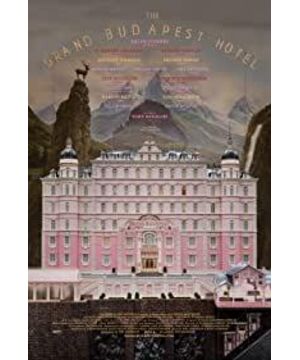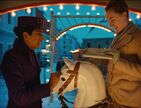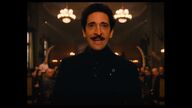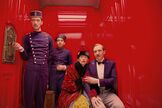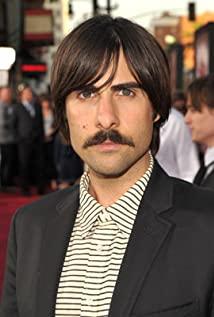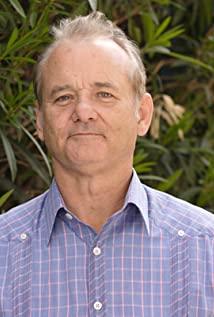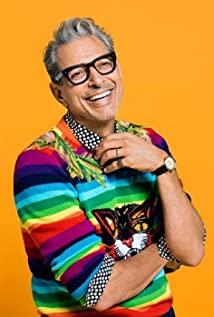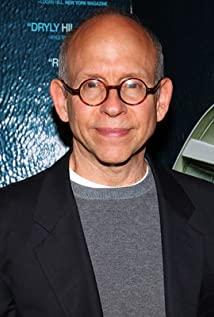Wes Anderson's new film "The Grand Budapest Hotel" can be described as a design feast. In March of this year, Creative Review magazine interviewed Annie Atkins, the chief graphic designer of the film, and talked about her How to collaborate with Wes to construct the fictional country of Qi Bailujia (State of Zubrowka). (The following pictures and texts are all from Creative Review, original _Designing for The Grand Budapest Hotel, translation_Feifei)
CR: How did you get into the film industry?
AA: I have been doing advertising for McCann Group in Reykjavik, Iceland for many years. At about that time, I started to write a blog, and I gradually felt that it was more enjoyable than being an art director. When I talked to the design director that I wanted to resign, he said that he read my blog and asked me if I would spend more time doing something "more emotional". I was very resistant at the time-"emotion"? ! But I thought he was right, so I went to Dublin and started film school, where I met Tom Conroy (art design for "Tudor"). He introduced me into a whole new world of design.
CR: Being able to participate in the production of this film should be an ideal career for many people. How did you join?
AA: Yes, this is definitely a dream job. I feel a little dizzy when I recall the first call from the producer of Wes. I was really stunned at the time. I still remember trying to make myself sound professional and calm, but in fact I started to roll over in the room. I was designing for Lycra’s new animation "Box Monster" (to be completed in September), and a designer in the studio (Nelson Lowry, the design of "The Great Fox Papa") recommended me to Wes. I think he tried to give me a little warning or something, and he emailed me saying "something bad is coming in your direction." But to be honest, I really don't know what he means, and I don't know how "bad" he is!
Qi Bailu's Canadian banknotes in the movie
CR: Can you tell you about the process of graphic design and prop design for the movie? Is Wes Anderson deeply involved?
AA: Wes will personally participate in all aspects of his own film production. I work with him and our art designer Adam Stockhausen every day. I think this movie is particularly interesting, from the point of view of graphic design, because we completely shaped Qi Bailujia Country-this fictional country described by Wes. This means that every detail must be made from scratch-flags, banknotes, stamps, everything. Before I joined this team, Adam had collected a large number of references from Eastern Europe in the 1930s. When I started designing every prop, I would show Weiss a craft that really existed in that era. Sometimes I can let him go through 20 design revisions a day. Weiss is particularly sensitive to images and pictures, which is clearly reflected in each of his movies. After each design has been finalized, we start to actually make these props, which are truly photogenic and will be held by the actors. I tried my best to use traditional methods to make these props: a typewriter from the 1930s was used to make all printed documents, and a pen that was really dipped in ink was used to make all handwritten documents. Everything must have a sense of age, and not look like it was just done by the art department five minutes ago. For example, Madame D's will took a considerable amount of time to make it old, because it has more than 600 sheets, and these papers and handwriting are at least 46 years old. Over the years I have also learned some tips in this area, most of the time you will need a big bucket of tea and a hair dryer.
The police report of the bizarre death of the lawyer Deputy Kovacs (Jeff Goldblum)
CR: This is a movie with a very rich font, from the hotel itself, to the title, to the Mendl snack shop, and even the prison gate. Font. Can you explain which fonts are used and why they were chosen?
AA: Actually, we use relatively few fonts in movies. Many fonts are handwritten. Wes and Adam have been investigating everything about Eastern Europe, and they have also collected information on various handwritten slogans over the past 100 years. The most beautiful thing about making a movie of a certain period in the past is that you can do graphic design for that era, even if the profession of graphic design did not exist at that time. The craftsmen at the time were designers: blacksmiths designed decorative letters on cast iron gates; glaziers carved decorative letters into stained glass; slogan painters painted decorative letters for shops to decorate the facade; printers chose fonts for letterheads.
The icon of the Grand Budapest Hotel itself-on the top of the hotel-is one of my favorite examples. Its prototype is the steel signboard of a Cairo hotel in the 1930s selected by Wes. I hand-painted the same style of our hotel's signboard, which is a little bit uneven and lively serif. Then we handed over the artwork to our modelers for them to start making miniature models of the hotel. I still remember that they corrected the excessively wide spacing between the letters A and N, and then we asked them to widen it again, just like the reference material. It's this small habit, which is what Wes loves, and it's all included in his aesthetics. On the one hand, he is a perfectionist, but on the other hand, he does not like that everything is machine-made, or to some extent digitally produced.
The dinner menu at the hotel, front and back. The painting "The Boy with Apple" is one of the main clues in the plot,
Mendels' packaging box. Mendels is a snack shop highlighted in the movie.
CR: You spent the whole winter in the crew. What was a typical workday?
AA: Yes, that's crazy. There is quite a lot of graphic design in this movie, so my script analysis is as long as my arm. We started up in Berlin, and after a month, the whole group moved to a border town called Gorlitz in Poland, where we lived and filmed together. Adam designed the hotel's furnishings and decorations so that it fits into its skeleton-an old and beautiful Art Nouveau department store. The store has six floors and a terrace. Our office is located on the top floor. We can look down from the terrace every day, watching the arrangement and decoration come to life a little bit, it feels really special. I spend a lot of time every day discussing the details of the design back and forth with Wes, explaining their entire production process to Liliana Lambriev, the assistant artist, and then contacting the designer, decorator, prop designer, and art director to ensure They can get the information they need from us in time.
There may be more design parts in a movie than it seems. For example, if a character’s office has a large, eye-catching board, then you have to fill it with all kinds of related materials. All the materials need to be consistent with the background of the time and the director’s. Imagine. The design is not made for the camera: many designs will not be seen by the audience in the theater at all, but you still have to create that atmosphere so that the actors can use their magic into the world.
One night I chatted with Ralph Fiennes. He particularly admired the design work in the movie, and especially liked a small notebook with an obvious personal style-it was designed by us for his character, and he can put it in his pocket. When we were conceiving, he suggested that the notebook should be designed with grid lines instead of blank inner pages, because he felt that it was more in line with Gustav's style. This kind of detail can never be captured by a camera, but it does help in the construction of a certain scene. For example, when Ralph strode across the hotel lobby while taking notes. Costumes, scenery, makeup, props, each department puts as much effort into creating details-and these are all integrated in the end.
Tilda Swinton's character-Madame D-a will to Gustave (Ralph Fiennes) (written in the hotel newspaper) and a photo of her body, right next to the business card of the evil Jopling (Willem Defoe)
Agatha's passport : These small objects can only get a brief glimpse in the movie, but they are all carefully made by Atkins
. The decoration of the Budapest Grand Hotel in the modern communist era: pay attention to the slogan
CR: The hotel in the communist era is full of various slogans, tell What should people do and where should they go, whose idea is this? What did you hope to get from the design of these slogans?
AA: Oh my god, there were so many slogans in the hotel lobby in the 1960s! I have to thank Liliana for this, she is basically responsible for this. She let three people from Berlin who specialize in slogans work for a whole week without interruption, just to finish painting them before our first day of filming. That set happened to be the first scene. Wes and Adam looked at a lot of slogans of East Germany's domineering communist era: Don't do this, don't do that, do this as required! Those slogans did intensify the feeling of claustrophobia under the setting, and Wes specifically asked them to be made into simple handwritten styles with white characters on a black background-based on the design of the old placards at the Yorckstrasse subway station in Berlin.
CR: What is your favorite work designed for this movie?
AA: My favorite is of course the book that introduced this story (see picture above). It is a modern pink hardcover book with the name of the Grand Budapest Hotel and the restaurant on the cover, as well as the name of the movie. This is a relatively simple design, but it is very special. After all, there are very few props that contain the name of the movie. I still remember that Wes sent me a sketch to present his idea of this book, and I really enjoyed the process of helping him realize this idea. I cherish this design very much, really-we made three books for shooting, in case it might be lost accidentally in heavy snow, so I took one home.
CR: What is the most challenging one?
AA: It may be the local newspaper in the hotel, "Trans-Alpine Yodel" (see picture above), because there are many issues in so many stories, and each issue has to be designed with a new one. Article, weather forecast and date. That was the first work I worked with Wes after I arrived in Germany, so it was really a prop for my "toddler". Through this design, I really felt his excessive demand for cleanliness-we had to review about 40 pages of different layouts, and after reviewing his satisfaction, we could start shooting! I also have to consider the aspect ratio during shooting, because the parameters are different in different periods. Weiss hopes that the width of the columns in the newspaper can fit well with the shooting of various aspect ratio screens. Wes personally wrote all the articles in the newspaper, not just those on the front page, but also on the corners. Of course, you can only see the title on the screen, but those stories are very Weisfan and very funny. I think he is very happy to design this design.
CR: What are you going to do next?
AA: I am currently working on Sam Mendes and John Logan's new play "Penny Dreadful", which is a thriller set in 1891. I really like to design for the Victorian period. This drama also has a lot of supernatural elements, so it's quite interesting. I also made some handwritten font sums for Darren Aronofsky's movie "Noah". It is also a very good work. It may be the oldest work involving the period I have participated in so far. I think I will do something new and trendy in the future, don't stay in the field you are used to. But you will never know what the next step will be. I just have to wait and watch the changes.
(This article source: voiceer.me)
View more about The Grand Budapest Hotel reviews


